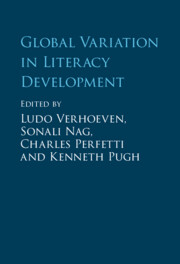Book contents
- Global Variation in Literacy Development
- Global Variation in Literacy Development
- Copyright page
- Contents
- Figures
- Tables
- Contributors
- Abbreviations
- 1 Introduction
- Part I Regional Variations
- Part II Neurobiological and Ecological Markers
- 11 Writing Systems and Global Literacy Development
- 12 Brain Foundations for Learning to Read
- 13 Genetics and Literacy Development
- 14 Role of Self-Regulation in the Transition to School
- 15 Socioeconomic Status, Sociocultural Factors, and Literacy Development
- 16 Sensitivity to Contextual Factors in Literacy Interventions in the Global South
- 17 How Teachers Contribute to Children’s Literacy Success
- 18 The Literacy Ecology of the Home
- 19 Parental Literacy Support in Monolingual and Bilingual Contexts
- 20 Global Literacy
- Index
- References
11 - Writing Systems and Global Literacy Development
from Part II - Neurobiological and Ecological Markers
Published online by Cambridge University Press: 23 November 2023
- Global Variation in Literacy Development
- Global Variation in Literacy Development
- Copyright page
- Contents
- Figures
- Tables
- Contributors
- Abbreviations
- 1 Introduction
- Part I Regional Variations
- Part II Neurobiological and Ecological Markers
- 11 Writing Systems and Global Literacy Development
- 12 Brain Foundations for Learning to Read
- 13 Genetics and Literacy Development
- 14 Role of Self-Regulation in the Transition to School
- 15 Socioeconomic Status, Sociocultural Factors, and Literacy Development
- 16 Sensitivity to Contextual Factors in Literacy Interventions in the Global South
- 17 How Teachers Contribute to Children’s Literacy Success
- 18 The Literacy Ecology of the Home
- 19 Parental Literacy Support in Monolingual and Bilingual Contexts
- 20 Global Literacy
- Index
- References
Summary
This chapter deals with global literacy development in relation to writing systems. A global perspective on literacy compels attention to global variation in languages and writing systems. The history of writing involves processes of discovery, borrowing, and modification, which language communities go through when they move toward a literate society. These processes require choices to be made regarding the graphic forms and how they connect to the spoken language and to broader cultural and educational considerations, including how new generations can learn this writing to understand their language. Across the globe, writing systems have developed varying solutions as to how to represent their spoken language, that is, its phonological, morphological, and semantic properties. In this chapter, some of the solutions to this mapping problem through invention and variation will be examined , and cognitive principles aiding the process of learning to read across languages and writing systems are proposed. The chapter concludes that writing systems follow the same set of operating principles in learning to read but that the they differences between them do matter for in terms of understanding the weighting of reading procedures and different educational challenges. It is also emphasized that all writing systems are learnable, and instruction effectively geared toward their specific properties may be successful for most children.
Information
- Type
- Chapter
- Information
- Global Variation in Literacy Development , pp. 241 - 264Publisher: Cambridge University PressPrint publication year: 2023
